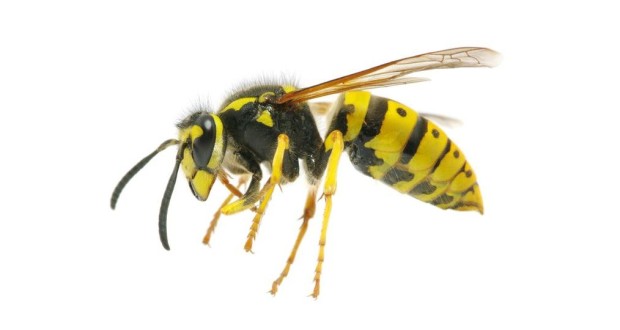The great outdoors have many alluring aspects, especially during the spring and summer months, when the temperatures warm up and plant life blooms. Unfortunately, there are certain drawbacks to going outside during this time of year, not the least of which is the persistent presence of flying insects. Arguably the worst of this bunch are the flying insects of the Hymenoptera order – in other words, bees, paper wasps, yellow jackets and hornets. Being stung by one of these pests (or simply encountering them) sends many people scurrying back inside their homes.
Though most people think of them as more a nuisance than health treat, insect stings can occasionally be fatal. Consider that, from July to early October 2013, giant hornets killed 42 people and injured an additional 1600 in northwest China. Though few people in the US die from bee and wasp stings, million of Americans are attacked by these insects every single year.
To the untrained eye, it’s easy to mistake a yellow jacket for a honey bee, or a hornet for a paper wasp. While many flying insects have stingers, their temperaments and behavior around humans can vary wildly. Below are some brief descriptions of the prominent flyers buzzing around your front yard.
Honey Bees – It probably isn’t fair to dismiss honey bees as simply bothersome pests. Yes, they are responsible for countless numbers of insect stings, but they also play an irreplaceable role in our food supply. The main calling of a honey bee (excluding the hive’s queen and her drones) is to collect nectar, a substance it obtains from various plants. While collecting nectar for the hive, the honey bee inadvertently transports pollen from the plant’s stamens to stigma, fertilizing the plant and allowing it to eventually bear fruits or veggies.
Honey bees are generally too concerned with their nectar-gathering duties to attack humans. However, they will sting if they are attacked or otherwise feel threatened. As painful as honey bee stings are to humans, they exact a far heavier toll on the bee itself. After stinging its target, the bee’s stinger is torn from its body, leaving a large opening the bee’s body that kills it soon afterwards.
Bumblebees – The main differences between a honey bee and a bumble bee are easy to spot. Bumble bees are much bigger and hairier than honey bees, and are also less aggressive towards humans, moving in slow and sluggish patterns as they go about their work. Though they are noticeably passive, bumblebees will sting in self-defense. Bumble bees can sting a target repeatedly without harming themselves.
Paper Wasps – You wouldn’t expect insects to be able to produce paper, but paper wasps have gotten papermaking down to a science (hence the name, paper wasps). This paper is used to make umbrella-shaped nests that hang from roofs and ceilings. Aside from their shape and location, a paper wasp nest can be identified by the open combs that cover nearly its entire surface. Paper wasps are bigger than honey bees in terms of length (1” compared to ½”) and have much less hair. Their other key features include thin waistlines and yellow and black abdominal stripes.
Wasps in general have a bad reputation, something not helped by paper wasps’ penchant for building scary-looking nests on residential homes. Despite this image problem, paper wasps are not especially aggressive, but will not hesitate to attack in droves if their home is disturbed. Paper wasps can sting their victims an unlimited number of times.
Yellow Jackets – Now we’re getting to the really nasty critters. You may be surprised to learn that yellow jackets are actually a type of wasp, though they differ greatly from paper wasps in many respects. For starters, if you happen to be bothered by yellow jackets, there’s a good chance you won’t find their nest hanging from a roof. Instead, many yellow jacket colonies prefer to live underground, creating large nests in tunnels and other spaces made by burrowing rodents.
Yellow jackets are significantly more likely than bees or paper wasps to sting a person without being provoked. In addition, they do not take kindly to having their nests even slightly disturbed, and will respond in force to uninvited guests. Once on the hunt, groups of yellow jackets can pursue their prey for several hundred yards, and will sting their target over and over again should they reach it.
The yellow jacket does share some characteristics with paper wasps, such as a thin waistline and yellow and black stripes. A good way to tell the two apart is to look at their length; a yellow jacket usually measures in at ½ to ¾ of an inch, visibly shorter than the inch-long paper wasp.
Hornets – Hornets share two things in common with yellow jackets – they are a type of wasp, and you don’t want to get on their bad side. Like wasps, hornets create imposing nests made from paper, although their nests resemble the shape of a tear drop. These nests can often be found hanging from large branches or porches, with sizeable entrance holes near the bottom tip. A single nest can house hundreds or even thousands of hornets.
Hornets react harshly to those who harm their home, attacking external threats in swarms. Those unlucky enough to be caught in the wrath of a swarm can expect to be stung repeatedly by a seemingly endless number of hornets. Likewise, people who simply get too close to a hornet’s nest might find themselves on the receiving end of multiple hornet stingers.
Though they are both feared for their sting and aggressive attitude, there are some notable differences between yellow jackets and hornets. Yellow jackets are notorious scavengers, and will loiter around garbage looking for sweet-tasting liquids and meat to devour. They also have a tendency to invade picnics, where they are drawn by cups of soda, hot dogs and hamburgers. Of course, this can easily end with the yellow jacket stinging one or more unsuspecting picnickers before returning to the nest. A yellow jacket will also scarf down insect carcasses it finds pleasing to its tastes. In contrast, hornets (as well as paper wasps) prefer to feast on live insects for their nourishment. Neither hornets nor paper wasps pester human habitats seeking sugary drinks or food.
In terms of appearance, hornets are generally somewhat larger than yellow jackets, averaging roughly ¾” in length. Their bodies’ color scheme can also be much different; while yellow jackets are known for their yellow and black stripes, many hornets can be identified by the white stripes on their black abdomens (this particular insect is known as the bald-faced hornet).
Mud Daubers – Wait a minute… mud daubers? Yes, believe it or not, there is actually a type of a wasp known as mud daubers. True to their name, mud plays a key role in the lives of mud daubers, which use this substance to construct their oddly-shaped homes. Mud daubers nests tend to be found in sheds, barns, on the walls of various buildings and under bridges. The actual design of these nests depends on the type of mud dauber in question.
Black and yellow mud daubers connect several cylindrical columns together in a single cluster, and pave over them with a layer of mud. The end result is a small structure roughly the size of a fist or lemon. The organ pipe mud dauber is a far more ambitious builder, constructing elongated tubes fused together is the fashion of organ pipes (needless to say, this fact explains the name of the organ pipe mud dauber). This type of wasp has a shiny, black coloring. Rather than do the dirty work of building its own nest, blue mud daubers prefer to move into abandoned nests made by its black and yellow cousin. Blue mud daubers are hardly pushovers, however, as this type of wasp preys on black widow spiders for its meals.
The telltale traits of a mud dauber include wire-thin waistlines and lengthy bodies, which range in size from ¾” to 1”. Their bizarre and somewhat unnerving appearance belies their docile nature; mud daubers rarely sting people, even if their nest is threatened or attacked. As loathe as they are to sting, mud daubers could easily use their stingers if touched or directly assaulted.
 Natural Knowledge 24/7 Educate yourself with nutrition, health and fitness knowledge.
Natural Knowledge 24/7 Educate yourself with nutrition, health and fitness knowledge.






